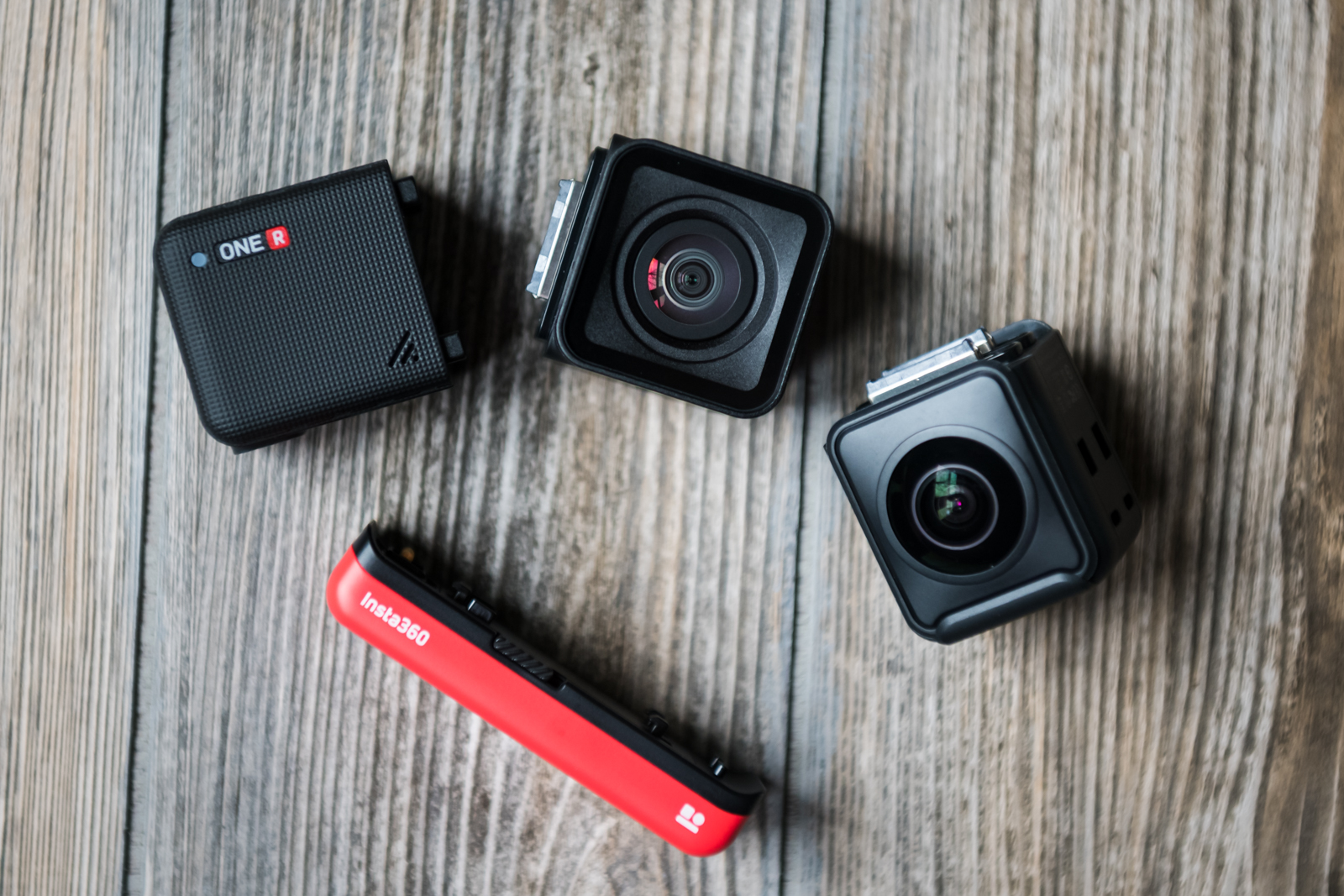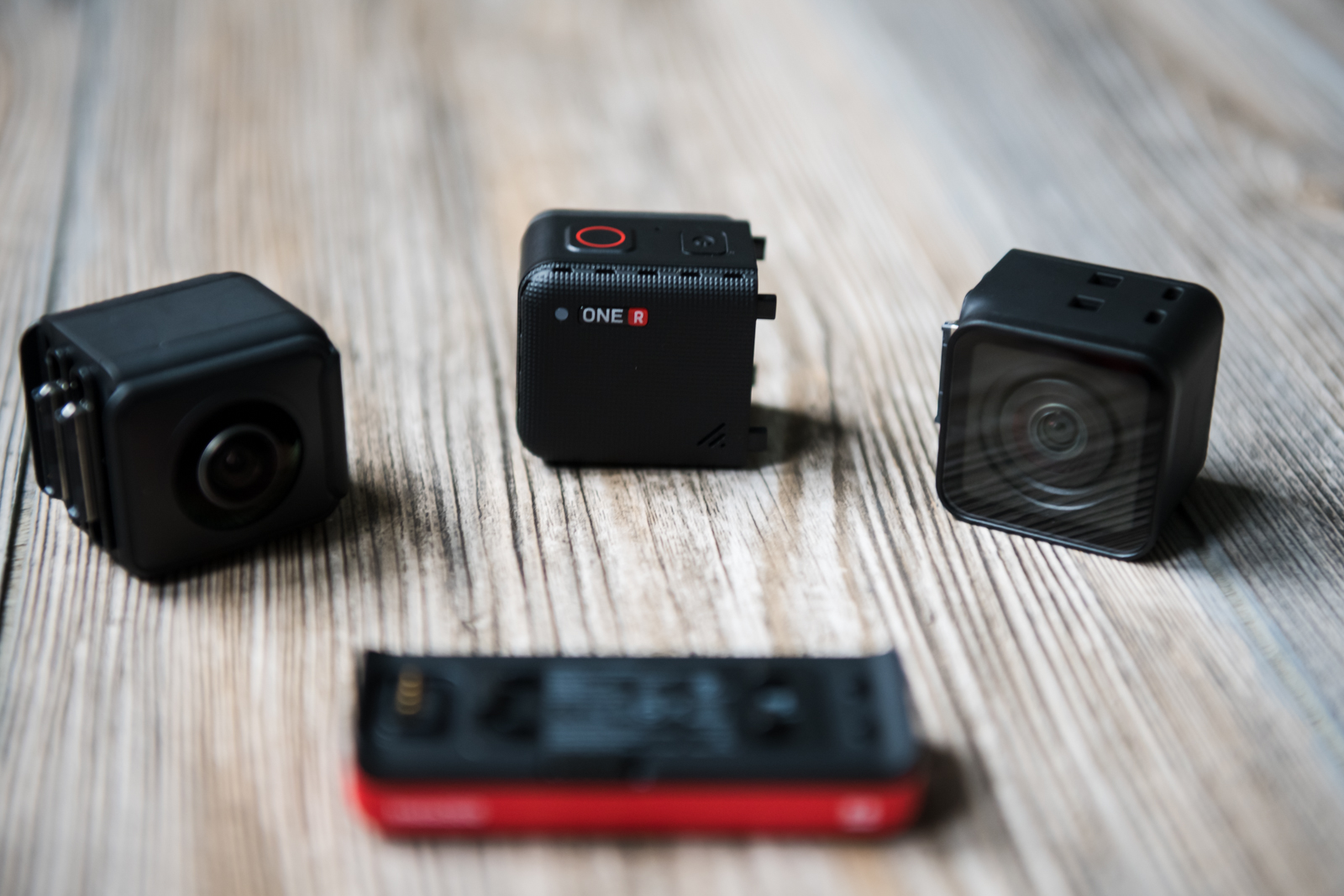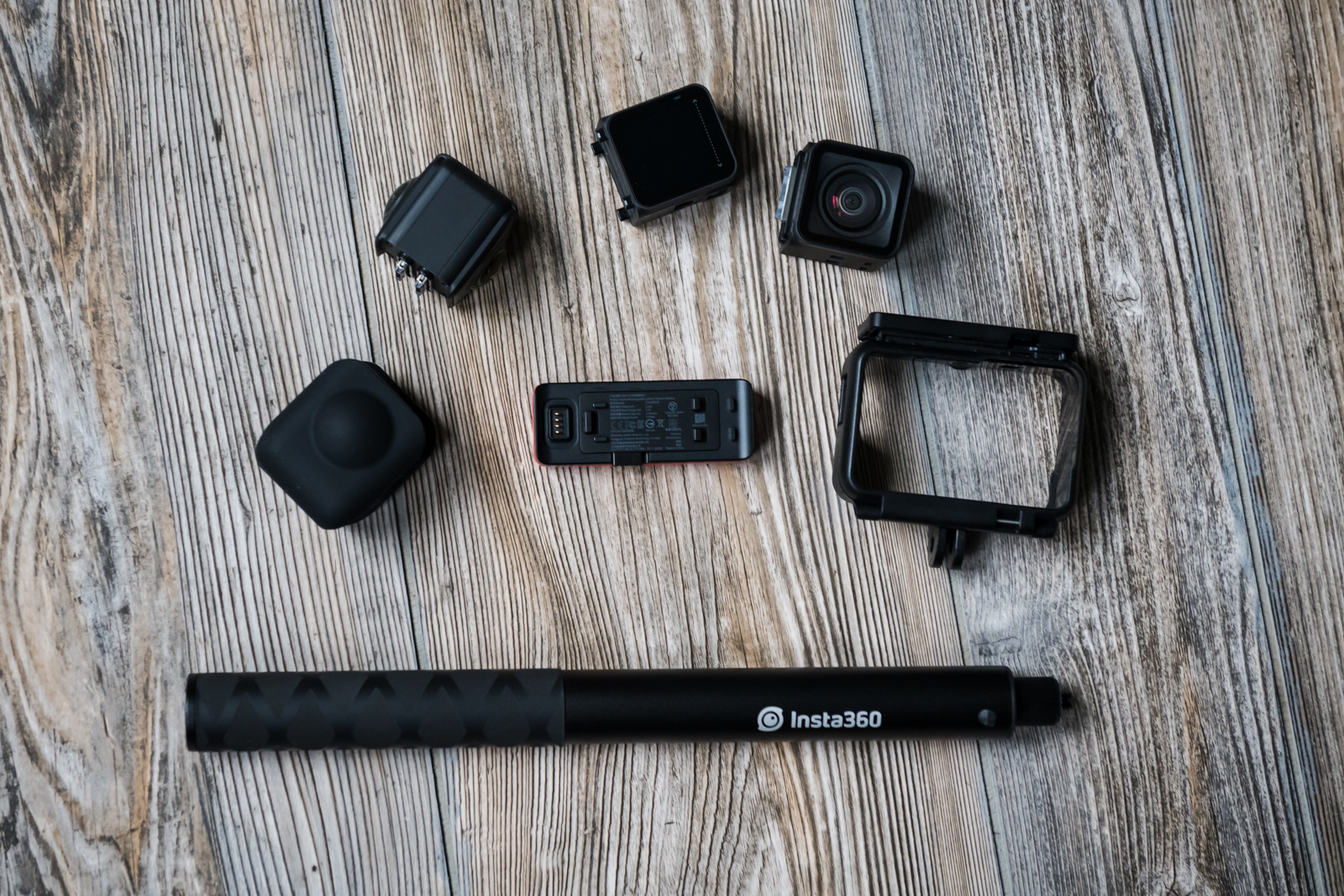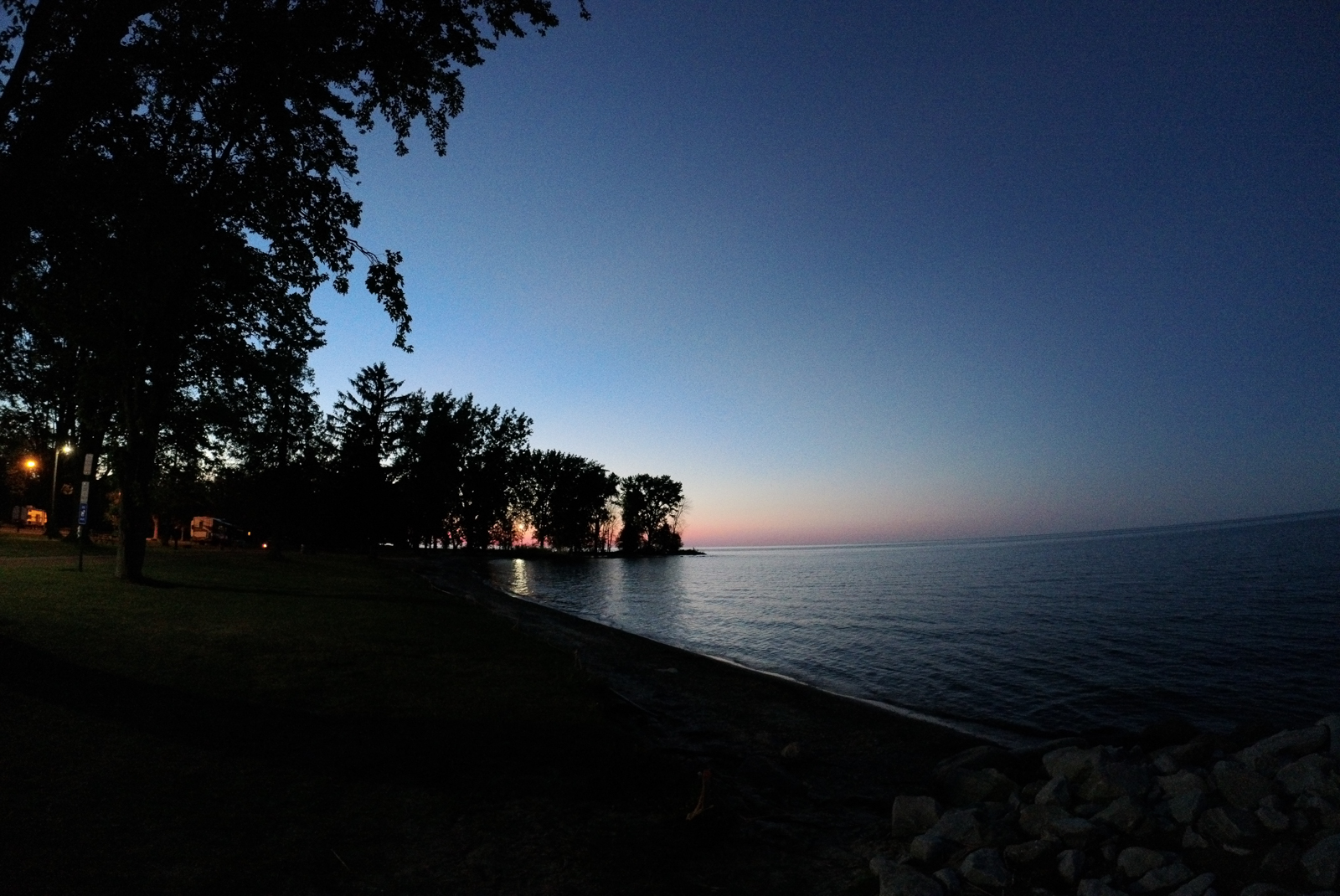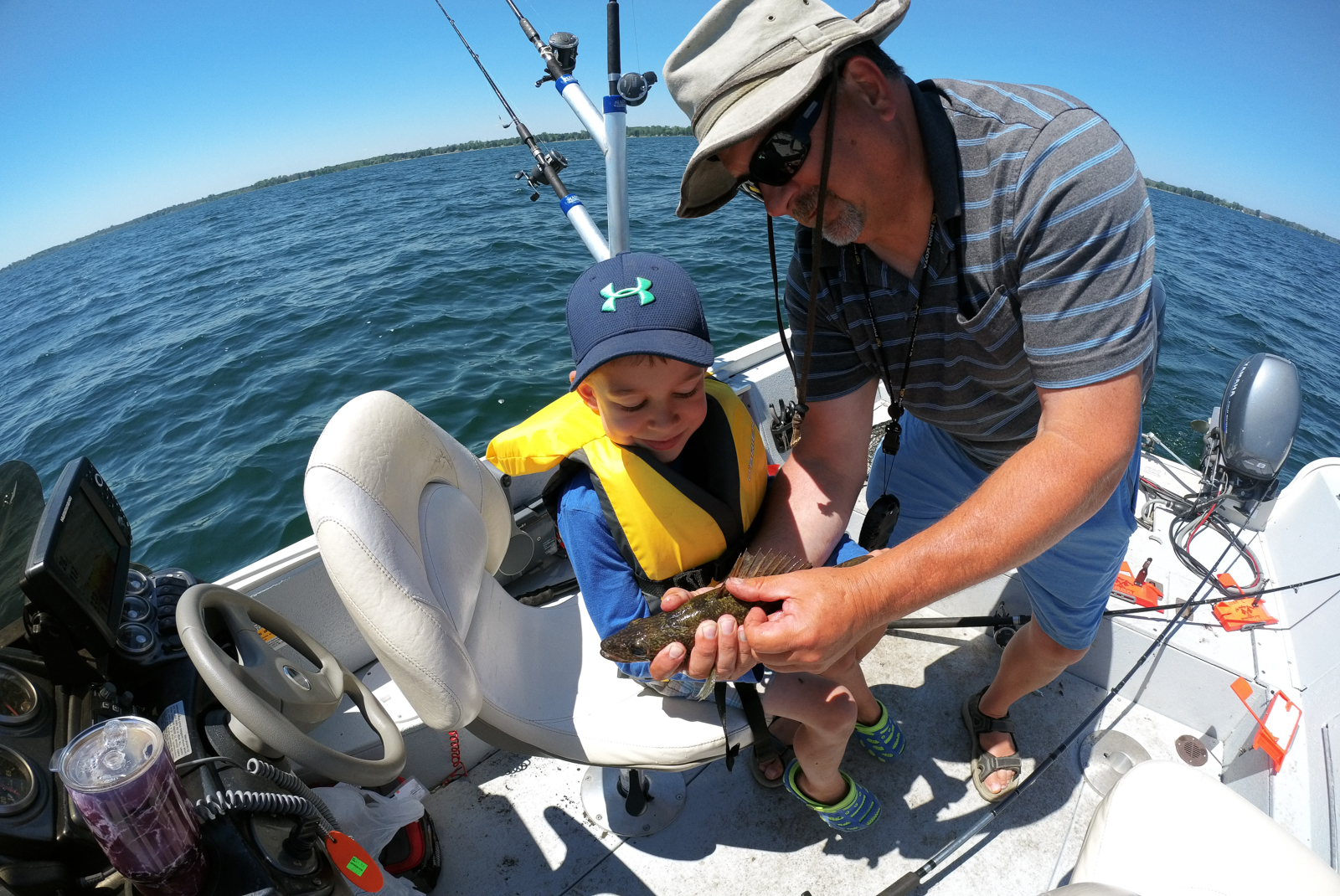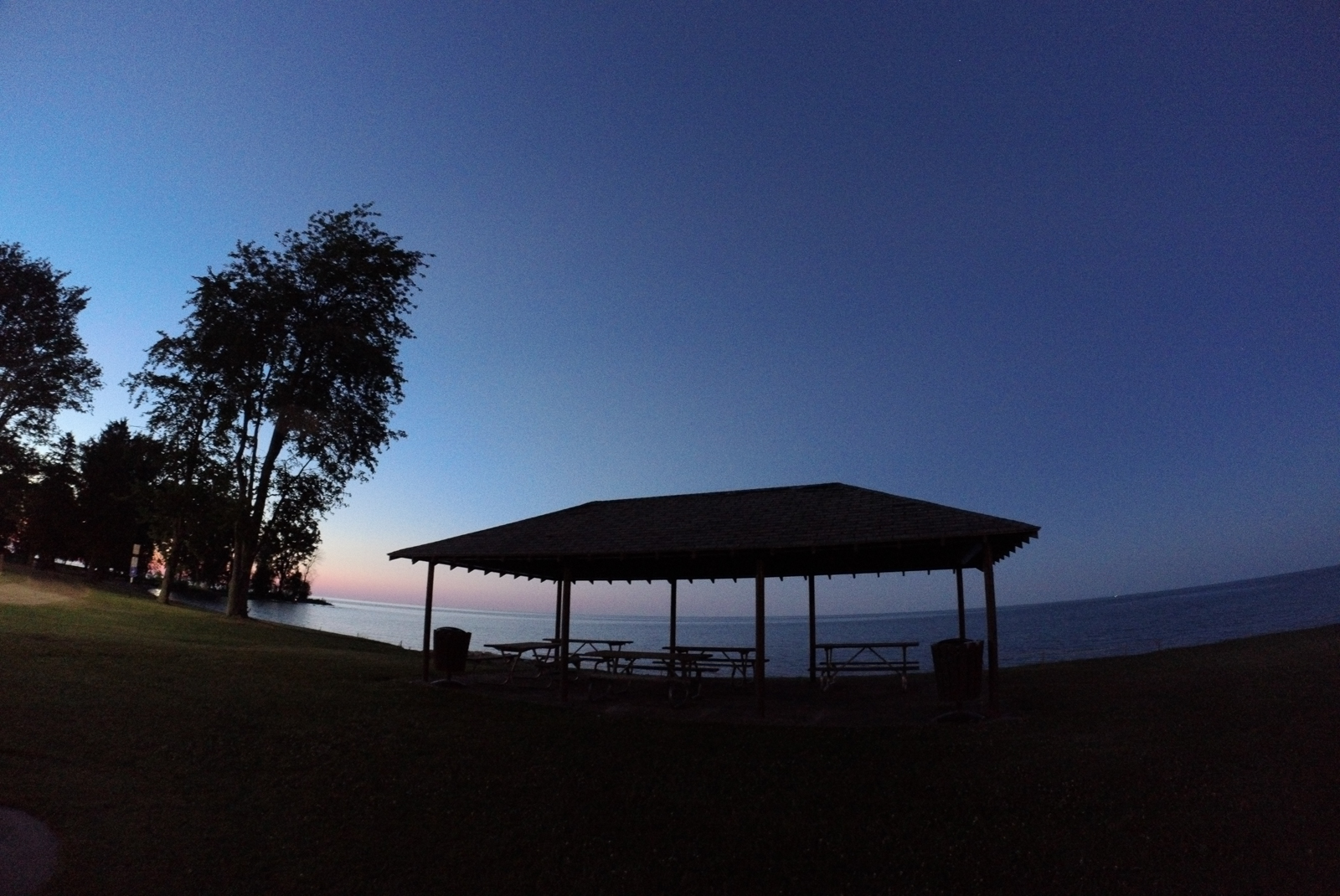- Modular design
- Excellent stabilization
- Sharp videos
- Long list of extra features
- Well-built editing app
- Competitive price
- Small screen
- Shutter lag
- Occasional bugs
Despite having the ability to see everything around them, 360-degree cameras have a limited number of uses. The Insta360 One R, however, isn’t your typical 360 camera. In fact, it doesn’t have to be a 360 camera at all. Its modular platform allows you to swap out the 360 lens for a traditional wide-angle action camera lens. There’s even a Leica-branded 1-inch sensor mod for capturing higher image quality and better low-light shots.
The One R is made of three main components — the swappable camera module, battery base, and touchscreen. Each is a separate piece, but the latter two are more permanent as they are used with either camera module. The $480 Twin Edition includes a 5.7K 360 mod and a 4K wide-angle mod. The 1-inch Edition includes the mod that houses a larger one-inch sensor for better image quality.
The Insta360 One R also builds in a long list of features and a well-designed mobile app for accessing them. It doesn’t just break 360 out of its niche — it competes with GoPro as an action camera.
We loved the Insta360 One R when we saw it at CES 2020, and it earned our Top Tech of CES award for the photography category. Let’s see if it lives up to our expectations.
Modular design
When assembled, the One R looks more or less like your typical action camera. A plastic guard wraps around the top and sides of all three pieces and includes a GoPro-compatible mount at the base.
The camera module connects to both the core (the part with the LCD screen) and the battery base. As a thoughtful addition for vloggers, the non-360 module can even be mounted backward, so the screen is visible while recording yourself. The camera module pops off the base at the pull of a tiny lever, then can be pulled free from the core with a good tug.

Despite being made of modular components, the Insta360 One R isn’t much larger than a typical action camera. Both the camera module and the core are roughly golf-ball-sized (if golf balls were, um, cubes). The small size makes for easy mounting in the traditional action camera sense, but you will want a selfie stick to keep fingers free of the lens to shoot the camera while holding it.
The 1-inch Edition also has a screw-on protective lens cover for the camera mod, which increases the camera’s overall size slightly and bumps out the mod further in the back as well. The lens also has a tendency to get condensation inside in humid environments, but only in the screw-on component.

The straightforward controls include a power button at the top right, with the record button next to it. A small door at the side houses a USB-C connection and MicroSD card slot.
The rest is done through the touchscreen. Most 360 cameras skip out on this and rely instead on a smartphone connection, so the screen is a big perk — big meaning important, as the actual size of the screen is only about an inch wide. That’s one limitation of the modular design.
The on-screen controls for shooting and playback are intuitive, but accessing them requires knowing the right gestures. A swipe to the left opens the shooting settings, while one to the right is playback. A swipe toward the top opens additional settings, and one to the bottom accesses different shooting modes. This isn’t too different from how many action cameras work, so it should be familiar to customers who have used something like a GoPro.

The touchscreen can also be a bit finicky. It often took a few swipe attempts to land at the mode I wanted without right past it.
The Insta360 One R is waterproof down to about 16 feet without an extra housing placed around it. (The included frame doesn’t offer additional water protection.) We tested the camera in a snowstorm — including flinging it off a sled into a pile of snow — and dunked it in a lake. Moisture didn’t get inside the camera itself, but there was some water between the modular components after its dunk in the lake.
The modular design may be unique, but the One R was still simple and easy to use. Remembering the gesture controls will take some time, but no more than with any other miniature camera. On the down side, the mode wheel constantly scrolled past the option we wanted, and it’s easy to push buttons accidentally when swapping mods.
Still, as a first-of-its-kind modular action camera, the One R gets a lot right.
User experience
Swapping lenses on an action camera is fun. Unlike a DSLR, you’re not swapping lenses to get closer or farther away, but based on whether you want an immersive view, a front-facing wide-angle camera, a rear-facing wide-angle camera, or a higher-resolution 1-inch sensor. Insta360 also includes the options to adjust the angle of view digitally. This will, of course, crop the video, but before throwing those pixels away, the One R uses the extra breathing room from the crop to improve the electronic image stabilization.
The on-camera controls offer enough that you can get away without relying on the mobile app, not that you’d want to skip out on it completely. Controlling the camera from the app opens up a long list of options, including manual exposure and RAW photos. The app also offers tutorials for both shooting and editing.
With the 360 lens, the app also allows for tracking — press and hold on the subject, and the 360 video will be adjusted so that person or object is always front and center. This tracking worked well and kept up even when the selected face was partially covered, though it does stop tracking if blocked from view completely. The 360 videos can be viewed in three primary perspectives: Ultra-wide, wide, or tiny planet (where the whole field of view is condensed into a circle that makes it look like you’re walking on a, well, tiny planet).
Where the app really shines is in editing. It felt more complete than the company’s desktop software, and had more options than most other mobile video apps. You can easily trim clips and add filters, and even stitch multiple clips together. You won’t find advanced editing controls, but for casual use, it gets the job done.
FlashCut is an option from the app’s Stories section that uses A.I. to turn multiple clips into an edited video quickly. Starting with a theme, you choose a few clips — you can see which ones you want by looking at the icons for the front camera, rear camera, forward motion, or faces. The app will then put them together with music and different special effects.
In fact, the app is too powerful for my due-to-be-replaced, forever-running-out-of-space iPhone 7. It did run seamlessly on the latest iPad, but owners of older devices should expect slow performance and a big space requirement (those 5.7K 360 files are not small).
If the app or the mini-touchscreen aren’t enough, voice control is also included for starting or stopping recording and marking important moments.
While the One R is both fun and intuitive to use, I did run across a few bugs. When I played back one of the first videos I shot, the video stuttered. An HDR photo also caused the camera to freeze. Finally, the camera froze up at the beach and wouldn’t respond to any controls until I restarted it by disconnecting the battery base. I couldn’t get the bugs to reoccur, but the experience wasn’t 100% seamless.
The other flaw with the user experience is speed. The camera has some shutter lag when shooting stills, not enough to disregard the camera entirely, but enough to be annoying and make timing still photos challenging.
The Twin Lens Edition
The 4K wide-angle mod snaps photos from an f/2.8 lens on a roughly 12-megapixel sensor. Videos can be full-sensor 4×3 (4000 x 3000) at 30 fps, or Ultra HD (3840 x 2160) at 60 fps. HD video is available at up to 200 fps for slow motion.
The 360 mod uses a slightly brighter f/2.0 lens. Stills are 18.4 megapixels while videos are 5,760 pixels wide. Remember, however, that pixels are spread across that entire 360-by-360-degree field of view instead of all being on the screen at once, so the actual resolution you see is much less.
Video from both mods met expectations for their respective categories, with good detail and color. Left on auto, exposure was generally good, with only an occasional need for a slight adjustment in post.
Still photos were consistent with what we expected from the action camera and 360 category. The wide-angle lens causes some noticeable barrel distortion but captures a nice wide view. Turning Color Plus on in the app after the fact creates nice vivid colors and boosts the shadows, but even without it, we were impressed by the bright blue skies and colorful details. HDR mode boosts the shadows a little as well, but takes longer and doesn’t work for moving subjects.
In the 360 mod, the camera did have some odd stitching on objects that were too close, blurring details, creating an abrupt transition, or even causing a color to bleed up the stitch line. Stitching on objects a foot or more away looked great, however.
The One R’s website shows off a starry time-lapse, but we just ended up with a grainy mess when attempting to photograph the stars with the camera’s Night Shot mode. This isn’t surprising given that it’s an action camera, but it is poor advertising.
The 1-inch Edition Leica Mod

Tiny cameras mean tiny sensors, but the 1″ Edition, as the name suggests, fits a 1-inch sensor inside the camera mod. Larger camera sensors gather more light, which means better low-light images, better depth of field, and a shallower depth of field.
The Leica mod offers excellent detail, shooting 5K video at 30 fps or 4K video at 60 fps. The mod uses a 14.4mm equivalent wide-angle lens, which is wide enough to bend the horizon but fits in plenty of the action. Colors are bright and the details are crisp. Quality is excellent for an action camera, and positions the camera well for competing with options like GoPro, especially among users most concerned with image quality.
Images get a bit noisy at ISO 1600, but I was impressively able to shoot photos handheld just after the sun slipped below the horizon. Images and video were both much more impressive coming from the 1-inch mode — I don’t see a reason to own both the 1″ and the wide-angle.
A shallower depth of field is typically a perk of larger sensors, but that’s not the case here. With the fixed autofocus, that’s typical of an action camera like this, which is actually slightly out of focus for closer mounts, such as on the handlebars of a bike, and would need a bit of finagling on an expanding selfie-stick to use for selfies and vlogging. The 1″ mod is one that should be used forward-facing and more than an arm’s distance from the subject.
Stabilization and other extras
Stabilization from all three mods is near-tripod excellent. I tested the camera on a boat (with the Leica mod), and the horizon stays steady while the boat that I’m standing in pitches back and forth. In that case, the stabilization is actually better than a tripod, because a tripod sitting on a boat is still going to sway back and forth with the waves.
The Insta360 One R brings the company’s features from several generations of cameras into one, including a long list of special features. The R is going to be one of those cameras that you can really explore and dig into tutorials that are built right into the app — or you’ll find a new feature you didn’t know you had a year from now.
The 360 mod can make a selfie stick look invisible or capture bullet-time effects. Hyper-lapses and slow-motion are built into both, as are HDR, Night Shot mode, and one-touch color grading with Color Plus. The R is even compatible with an Apple Watch app for remote shooting. Accessories also allow for adding on a microphone, shooting from an “invisible” drone, diving deeper underwater, or boosting the battery life.
Our take
The Insta360 One R does well at everything an action camera or 360 camera is capable of doing well at — and then some. Video is not only solid, but paired with excellent stabilization. The Insta360 One R isn’t perfect, with a few minor bugs, freezes, and a shutter lag when working with stills. Insta360 released at least two firmware updates while we were testing, so the bugs and freezes will hopefully be temporary. But, the modular design, video quality, and extra features — not to mention the competitive $480 price for the Twin Edition and $550 for the Leica Edition — are worth putting up with a few minor quirks.
Is there a better alternative?
Only if you want to buy two cameras. The Insta360 One R Twin Edition is essentially two cameras in one with the two mods. The Rylo’s ability to reframe and the easy-to-use app make it the closest competitor, but cropping from a 360 video and swapping camera mods are not the same. The tiny screen, shutter lag, and occasional freezes give the GoPro Hero8 an edge, but again, only if you only want an action camera without the 360 capabilities. And if you don’t need to shoot vlogs, the larger 1-inch sensor and excellent quality could be a reason to choose the 1″ Edition instead.
How long will it last?
The Insta360 One survived being flung into snowbanks and dunked into a lake without any issues. But, as a modular camera, there are more connections and things to potentially break, and there’s not enough history with modular cameras to determine if that will be the case here or not. At least with the mods, you don’t necessarily need to replace the entire thing if one component breaks.
Should you buy it?
Yes. If you can’t decide between an action camera and a 360 camera, or even if you are just looking for a 360 camera, buy the Insta360 One R. The videos are great, the versatility is unbeatable, the app extensive, and it’s simply a blast to shoot with.


